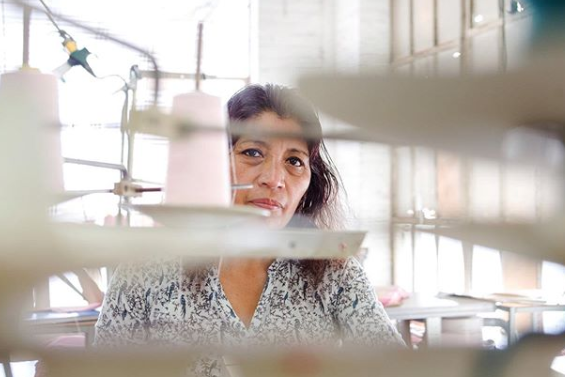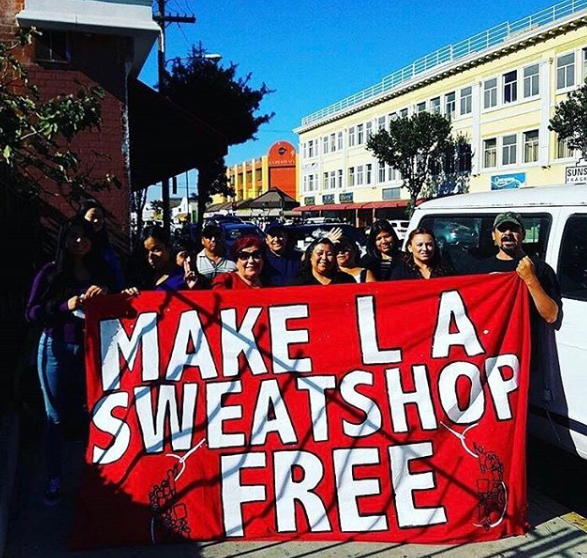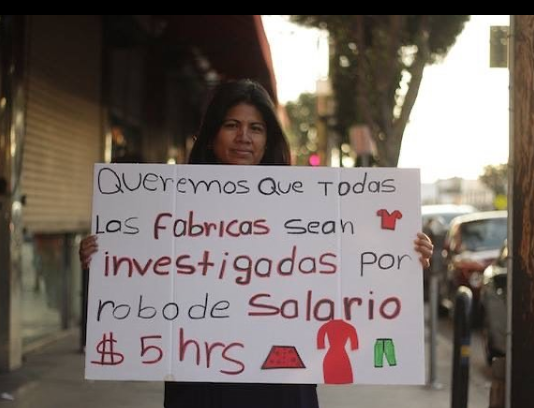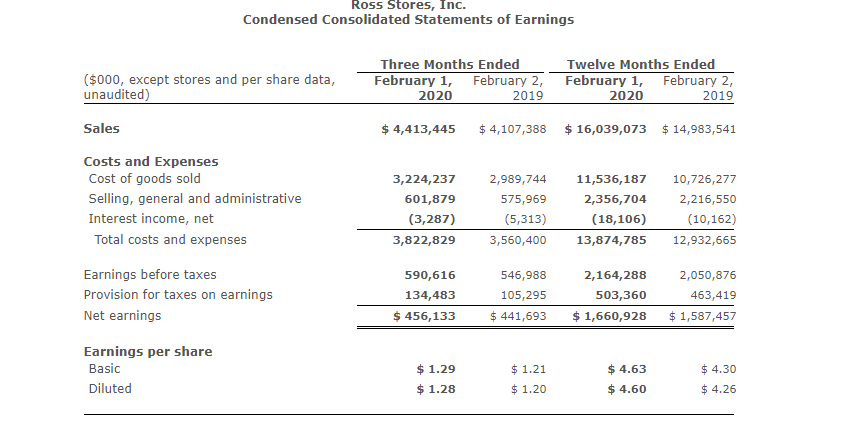Ross is Stealing from L.A Garment Workers
What do you think of when you read the “Made in U.S.A” label on your mint, new shirt? Do you feel pride and reassurance that your clothing was made in clean factories, with ethical policies and even distribution of wages? To your surprise, this is often not a reality. Los Angeles has the highest concentration of garment industry workers in the country. They are the city’s largest manufacturing sector and nation’s production capital. About 2,000 manufacturers employ more than 40,000 people, which are immigrants from Mexico and Central America and are predominantly female at a 60/40 percent ratio.These women work from 10-12 hours a day dyeing, cutting and sewing our designer knockoffs. In addition, they cut and sew garments for Ross despite the claims they only sell overstocked clothing from department stores.
L.A garment workers are subject to employment violations in the garment industry where they experience wage theft, unfair working conditions and are stripped of their fundamental human rights. This is because the industry operates under a complex, multi-layered system of competition. Factories have to obtain contracts by having quick turnaround and providing high volume. This is accomplished by contract owners which “sweat” workers for as much labor and productivity while the brand reaps all the profit. In other words, L.A garment workers are employed in sweatshops.
According to The Garment Worker Center, one L.A garment worker stated that:
“I've been working in garment for more than 30 years and it's been so much exploitation from the employers who don't pay well, insult us, and [physically] throw the work at us. My husband and I have spent our lives working in garment. I'm paid $200-$300 a week working from 7am to 8pm, sometimes Saturdays and Sundays, to make more money and make more pieces. They make us sign papers to say they are paying us correctly but it's not true. Where I was working before the pandemic - they are still operating, sitting very closely together and without distance. They still owe me a day of work from before the pandemic and I've called my boss but they do not answer. I want changes for us but also for those coming after me."
Photo Courtesy of The Garment Worker Center
Approximately 60% are not paid minimum wage and 93% are not provided overtime wages. In addition, working conditions are abhorrent. According to The Garment Worker Center:
workers toil in overcrowded factories
cardboard boxes and fabric bundles block safety exits, which are often locked
factories are sweltering because of poor ventilation and industrial steam presses
factories lack filters to reduce fabric fibers in the air, causing risk of respiratory illness
workers don’t have access to clean bathrooms or drinking water
workers receive punctures from sewing machine needles and tag guns
factories provide no assurance of equipment sanitization
workers are not provided First Aid kits, which leaves workers to use discarded fabric and oil to treat wounds
workers suffer from repetitive motion injuries to their wrist, shoulders and back
workers suffer from eye strain because of low lighting
Photo Courtesy of The Garment Worker Center
Despite prior attempts of worker protection laws, such as the Assembly Bill 633, retailers and manufacturers have found ways to avoid being held liable for unethical business practices. This has effectively resulted in the current exploitation of workers that experience wage theft and are not able to recover stolen wages that they fairly worked for. This wage theft has caused a low payout of $5 an hour for workers employed at 50-60 hours per week, resulting in earnings as low as $300 a week.
This has been facilitated by a loophill in state law that does not hold Ross liable, despite evidence that the clothing sold in their stores were made in their own factories. The Labor Department can only penalize companies that directly employ workers. Since retailers keep their distance from the factories through subcontracting, they get away with layers of suppliers. This business model helps them avoid legal repercussions and allows them to provide insufficient pay rates to the manufacturer/factory every year. Unfortunately, contractors have been paid around 70% of what is needed to pay their workers a minimum wage. This unfair pricing has led to wage theft because the retailers always set and pay what they want for the garments.
This is a cost effective strategy for Ross to pay less for the work done by its labor force. However, this enables Ross to make it impossible for workers to earn the minimum wage per hour. As a result, this has caused frustration for workers that struggle to survive because they have no guarantee of how much they will earn per hour and week to week nor the amount of hours they will work during the day.
Photo Courtesy of The Garment Worker Center
Adding to the problem, garment workers can be paid by the piece. Within this pay system, workers can earn as low as $0.03 per assembly operation. It is also common for employers to reduce already promised piece rates. This creates unsafe working conditions because workers have to work at a maniac speed to complete as many items as possible. As a result of the piece rate system, this intrudes upon garments being able to take breaks. If breaks were to be provided, they would go unpaid. All the while, with workers employed during the pandemic, it prevents proper sanitation and hygiene to be facilitated.
Ross garment workers are fed up and have had enough. Workers have not been able to collect owed wages from the factory Sam’s Fashion and Ross’s manufacturer, YN Apparel. The factories shut down on purpose to avoid worker wage pay outs, also known as “cutting and running”. In other words, the factories preferred to fire everyone and shut down to avoid paying the wages owed to their workers.
With the help of the Garment Worker Center, L.A garment workers have written demand letters, picketed stores and issued delegations. There has been no response from Ross. Sadly during these campaigns for further accountability of sweatshop conditions, Ross profits have grown. They earned $14 billion in profits in 2018 and expanded by opening 200 new stores.
Photo Courtesy of The Garment Worker Center
Now contrast this to Ross’s current decision to NOT pay their workers during COVID-19 for the orders they have already fulfilled. Ross has shut down its factories, dismissed their workers and not paid for the work and completed pieces.Their condensed, consolidated statement of earnings is clear evidence of the years of corporate greed built on the backs of worker exploitation. Their earnings have increased while workers have been dismissed and ignored.
Photo Courtesy of Ross Stores Investors
However, L.A garment workers have been hard at working in passing the SB- 1399. This bill aims at expanding the definition of garment manufacturing, which includes the dying, design altering and label affixing on garments. It also aims in eliminating brands ability to pay by the piece or unit, except under specific conditions. In addition, it would hold the individuals engaged in garment manufacturing contracts share joint and liability with contractors and brand guarantors. This would provide the framework for civil legal responsibility and liability for workers employed by the contractor. All the while, it would require everyone to pay for the unpaid minimum wages, break premiums, overtime pay and any damages or penalties, and compensation coverage.
In sum, SB 1399 would help strengthen the current law to ensure the protection of garment workers in three primary ways:
Expand liability, ensuring brands and retailers cannot use layers of contracting to avoid behind held liable
Prohibit the use of paying workers by the piece, which would eliminate workers being less than minimum wage and help ensure their health and safety
Explicitly authorize the Labor Commissioner’s Bureau of Field Enforcement (BOFE) investigate and cite guarantors for wage theft.
Photo Courtesy of The Garment Worker Center
Despite The Garment Worker Protection Act (SB 1399, Durazo) being passed through the Senate Appropriations Committee with a 5-2 vote on June 18th, 2020, more work needs to be done. SB 1399 has moved into to the full Senate for a vote in the week of June 22-27, 2020.
To support LA garment workers, the following are powerful suggestions:
Support garment workers by sending Ross an online letter: https://actionnetwork.org/letters/rossexploits/
Stay informed by heading to The Garment Worker Center: http://garmentworkercenter.org/rossexploits/
Follow The Garment Worker Center on social media
Place informative flyers of worker exploitation outside Ross stores, templates here
Use the hashtag #PayUpRoss, #SB1399 #onelegalwage #minimumwagenow and #GarmentWorkerCenter on social media and tag The Garment Worker Center if you make a post on this topic
Make a post using #RossExploits #PayUpRoss #YesForLessSweatshops #RossFinds #WageTheft and tag @RossDressforLess on Instagram or Facebook
Consider boycotting the following brands. Besides Ross, garment workers in L.A have been subject to worker exploitation from a number of different brands. The following thirteen have been banned:
Ross
Forever 21
Burlington
Fashion Nova
Windsor
Dillards
Urban Outfitters
TJ Maxx
Nordstrom
Beall’s
Charolotte Russe
Macy’s
A’gaci
To Learn More:
Get Informed: The Garment Worker Center: https://garmentworkercenter.org/getinformed/
Sewing Resileince- Short Film: https://www.youtube.com/watch?v=wxNd3q94KjQ&t=509s
L.A Article: https://www.latimes.com/business/la-fi-wage-theft-forever-ross-20161116-story.html
SB-1399 Bill Text: https://leginfo.legislature.ca.gov/faces/billTextClient.xhtml?bill_id=201920200SB1399
#RossExploits Campaign Videos: https://garmentworkercenter.org/rossexploits/la-garment-workers-take-on-ross-video/?%3E






